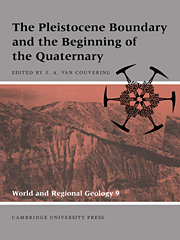Book contents
- Frontmatter
- Contents
- List of contributors
- Preface: the new Pleistocene
- Foreword
- Part I Definition of the base of the Quaternary
- Part II Characterization of the Pleistocene boundary-stratotype
- 2 The Pliocene–Pleistocene boundary-stratotype at Vrica, Italy
- 3 The magnetostratigraphy of the Vrica section, Italy, and its correlation with the Plio–Pleistocene of the Boso Peninsula, Japan
- 4 Comparison of the laminated units at Vrica and deep-sea sapropels from the eastern Mediterranean
- 5 Calcareous nannofossil biochronology and the Pliocene–Pleistocene boundary
- 6 Diatom microfossils from the Vrica section
- Part III The paleontological context of the Pleistocene boundary
- Part IV The Pleistocene boundary in regional sequences
- Index
6 - Diatom microfossils from the Vrica section
Published online by Cambridge University Press: 10 November 2009
- Frontmatter
- Contents
- List of contributors
- Preface: the new Pleistocene
- Foreword
- Part I Definition of the base of the Quaternary
- Part II Characterization of the Pleistocene boundary-stratotype
- 2 The Pliocene–Pleistocene boundary-stratotype at Vrica, Italy
- 3 The magnetostratigraphy of the Vrica section, Italy, and its correlation with the Plio–Pleistocene of the Boso Peninsula, Japan
- 4 Comparison of the laminated units at Vrica and deep-sea sapropels from the eastern Mediterranean
- 5 Calcareous nannofossil biochronology and the Pliocene–Pleistocene boundary
- 6 Diatom microfossils from the Vrica section
- Part III The paleontological context of the Pleistocene boundary
- Part IV The Pleistocene boundary in regional sequences
- Index
Summary
Introduction
The marine strata exposed at Vrica, in Calabria, were proposed by Selli et al. (1977) as the Pliocene–Pleistocene boundary-stratotype section because those strata, originally deposited at depths between 500 and 800 m, offered the potential for correlation of oceanic microfossils with established datum levels. Backman, Shackleton, and Tauxe (1983) and Rio, Raffi, and Backman (Chapter 5, this volume) correlated the calcareous nannofossils from Vrica to those recovered from deep-sea piston core V28–239, taken at a depth of 3,490 m on the Solomon Rise in the western equatorial Pacific. In that biostratigraphy, supported by observations from other cores, the first appearance of Gephyrocapsa s.l. just above the Olduvai subchronozone and the global extinction of Calcidiscus macintyrei at a slightly higher level are the closest available approximations of the boundary, which is located within the uppermost part of the Olduvai at approximately 1.8 Ma (Pasini and Colalongo, Chapter 2, this volume), and not above the subchron, according to the data of Tauxe et al. (1983) (Figure 6.1).
Diatom assemblages of Plio–Pleistocene age have been reported from deep-sea sites around the globe, with emphasis on the Pacific Ocean (Burckle and Todd, 1976; Barron, 1980a,b; Koizumi, 1985). More detailed studies in the northwest Pacific (Koizumi, 1985, 1992), Kamchatka (Gladenkov, 1994), northeast and southern Pacific (Schrader, 1973, 1976), and the Southern Ocean (McCollum, 1975; Gombos, 1976) support the regional analysis. Research by Burckle and co-workers (e.g., Saito, Burckle, and Hays, 1975; Burckle and Opdyke, 1977; Burckle and Trainer, 1979) was based on integration of diatom datum levels and magnetostratigraphy.
- Type
- Chapter
- Information
- Publisher: Cambridge University PressPrint publication year: 1996



